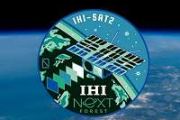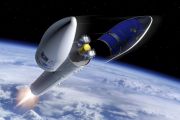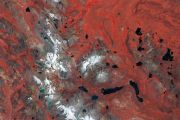
Copernical Team
Robots set to move beyond factory as AI advances
 Today's robots perform safety checks at industrial plants, conduct quality control in manufacturing, and are even starting to keep hospital patients company.
But soon - perhaps very soon - these increasingly humanlike machines will handle more sophisticated tasks, freeing up people while raising complex questions about the roles of artificial intelligence that are gaining attention.
At
Today's robots perform safety checks at industrial plants, conduct quality control in manufacturing, and are even starting to keep hospital patients company.
But soon - perhaps very soon - these increasingly humanlike machines will handle more sophisticated tasks, freeing up people while raising complex questions about the roles of artificial intelligence that are gaining attention.
At JAXA's Wooden Satellite LignoSat Deployed from Space Station
 In December 2024, five CubeSats were released into Earth's orbit from the International Space Station (ISS), marking a significant milestone for space innovation. Among these satellites was LignoSat, an experimental wooden satellite developed by the Japanese Aerospace Exploration Agency (JAXA). This unique project explores the feasibility of using wood as a sustainable material for spacecraft co
In December 2024, five CubeSats were released into Earth's orbit from the International Space Station (ISS), marking a significant milestone for space innovation. Among these satellites was LignoSat, an experimental wooden satellite developed by the Japanese Aerospace Exploration Agency (JAXA). This unique project explores the feasibility of using wood as a sustainable material for spacecraft co York Space Systems Achieves First LEO to LEO Laser Link Between Vendors
 York Space Systems (York), a Denver-based aerospace innovator specializing in the rapid deployment of comprehensive space mission solutions, has successfully executed the first inter-vendor laser communication link in low Earth orbit (LEO) for the Proliferated Warfighter Space Architecture (PWSA). This achievement connected a York-built Tranche 0 Transport satellite with a Tranche 0 Tracking sat
York Space Systems (York), a Denver-based aerospace innovator specializing in the rapid deployment of comprehensive space mission solutions, has successfully executed the first inter-vendor laser communication link in low Earth orbit (LEO) for the Proliferated Warfighter Space Architecture (PWSA). This achievement connected a York-built Tranche 0 Transport satellite with a Tranche 0 Tracking sat Monitoring space traffic
 AeroAstro PhD student Sydney Dolan uses an interdisciplinary approach to develop collision-avoidance algorithms for satellites.
If there's a through line in Sydney Dolan's pursuits, it's a fervent belief in being a good steward - both in space and on Earth.
As a doctoral student in the MIT Department of Aeronautics and Astronautics (AeroAstro), Dolan is developing a model that aims to mit
AeroAstro PhD student Sydney Dolan uses an interdisciplinary approach to develop collision-avoidance algorithms for satellites.
If there's a through line in Sydney Dolan's pursuits, it's a fervent belief in being a good steward - both in space and on Earth.
As a doctoral student in the MIT Department of Aeronautics and Astronautics (AeroAstro), Dolan is developing a model that aims to mit Siemens launches initiative to support startups with advanced technology
 Siemens has introduced Siemens for Startups, a strategic initiative designed to support early-stage companies in the engineering and manufacturing sectors. Announced at CES 2025 in Las Vegas, this program aims to foster innovation, streamline development, and expedite scaling by offering access to Siemens' software, hardware, and venture-related services at reduced costs.
"Startups are ess
Siemens has introduced Siemens for Startups, a strategic initiative designed to support early-stage companies in the engineering and manufacturing sectors. Announced at CES 2025 in Las Vegas, this program aims to foster innovation, streamline development, and expedite scaling by offering access to Siemens' software, hardware, and venture-related services at reduced costs.
"Startups are ess Nuclear fusion could one day be viable - but major challenges remain
 The way scientists think about fusion changed forever in 2022, when what some called the experiment of the century demonstrated for the first time that fusion can be a viable source of clean energy.
The experiment, at Lawrence Livermore National Laboratory, showed ignition: a fusion reaction generating more energy out than was put in.
In addition, the past few years have been marked
The way scientists think about fusion changed forever in 2022, when what some called the experiment of the century demonstrated for the first time that fusion can be a viable source of clean energy.
The experiment, at Lawrence Livermore National Laboratory, showed ignition: a fusion reaction generating more energy out than was put in.
In addition, the past few years have been marked Toyota invests $44.4M in private Japanese spaceflight company
 The Toyota Motor Corporation will invest $44.4 million in Japan-based Interstellar Technologies to help the private spaceflight firm develop rockets to launch satellites into Earth's orbit.
Toyota Chairman Akio Toyoda on Monday announced the automaker's intent to invest in Interstellar Technologies during the annual Consumer Electronics Show in Las Vegas.
While discussing Toyota's in
The Toyota Motor Corporation will invest $44.4 million in Japan-based Interstellar Technologies to help the private spaceflight firm develop rockets to launch satellites into Earth's orbit.
Toyota Chairman Akio Toyoda on Monday announced the automaker's intent to invest in Interstellar Technologies during the annual Consumer Electronics Show in Las Vegas.
While discussing Toyota's in SpaceX launches 21 Starlinks using 1st-stage on it's 25th mission; launches NRO spysat from Vandenberg
 SpaceX on Friday launched 21 Starlink satellites into low-Earth orbit with a Falcon 9 rocket whose reusable first stage took part in a record 25th mission.
Among the 21 satellites that lifted off from Space Launch Complex 40 at Cape Canaveral Space Force Station in Florida were 13 with direct-to-cell capabilities, SpaceX said.
"The Starlink Direct to Cell constellation now has 40
SpaceX on Friday launched 21 Starlink satellites into low-Earth orbit with a Falcon 9 rocket whose reusable first stage took part in a record 25th mission.
Among the 21 satellites that lifted off from Space Launch Complex 40 at Cape Canaveral Space Force Station in Florida were 13 with direct-to-cell capabilities, SpaceX said.
"The Starlink Direct to Cell constellation now has 40 SpaceX launches new round of spy satellites for NRO
 SpaceX launched new spy satellites into lower Earth orbit for the National Reconnaissance Office, adding to the growing constellation of such U.S.-based intelligence-gathering satellites around the world.
The SpaceX Falcon 9 rocket launched the NROL-153 mission into space late Thursday from the Vandenberg Space Force Base in California with "classified payloads."
"Building on the
SpaceX launched new spy satellites into lower Earth orbit for the National Reconnaissance Office, adding to the growing constellation of such U.S.-based intelligence-gathering satellites around the world.
The SpaceX Falcon 9 rocket launched the NROL-153 mission into space late Thursday from the Vandenberg Space Force Base in California with "classified payloads."
"Building on the SpaceX launches 21 Starlink satellites in 25th mission for 1st-stage booster
 SpaceX on Friday launched 21 Starlink satellites into low-Earth orbit with a Falcon 9 rocket whose reusable first stage took part in a record 25th mission.
Among the 21 satellites that lifted off from Space Launch Complex 40 at Cape Canaveral Space Force Station in Florida were 13 with direct-to-cell capabilities, SpaceX said.
"The Starlink Direct to Cell constellation now has 40
SpaceX on Friday launched 21 Starlink satellites into low-Earth orbit with a Falcon 9 rocket whose reusable first stage took part in a record 25th mission.
Among the 21 satellites that lifted off from Space Launch Complex 40 at Cape Canaveral Space Force Station in Florida were 13 with direct-to-cell capabilities, SpaceX said.
"The Starlink Direct to Cell constellation now has 40 





























